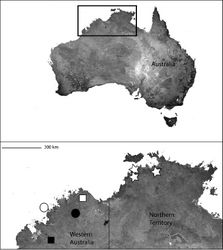Karaops jenniferae
| Notice: | This page is derived from the original publication listed below, whose author(s) should always be credited. Further contributors may edit and improve the content of this page and, consequently, need to be credited as well (see page history). Any assessment of factual correctness requires a careful review of the original article as well as of subsequent contributions.
If you are uncertain whether your planned contribution is correct or not, we suggest that you use the associated discussion page instead of editing the page directly. This page should be cited as follows (rationale):
Citation formats to copy and paste
BibTeX: @article{Crews2011ZooKeys99, RIS/ Endnote: TY - JOUR Wikipedia/ Citizendium: <ref name="Crews2011ZooKeys99">{{Citation See also the citation download page at the journal. |
Ordo: Araneae
Familia: Selenopidae
Genus: Karaops
Name
Karaops jenniferae Crews & Harvey, 2011 sp. n. – Wikispecies link – ZooBank link – Pensoft Profile
Type material
Holotype female (WAM T65078): Oscar Range, Western Australia, Australia, 17°38'16"S, 125°10'08"E, 26.VII.2005, B. Maryan, active at night on limestone.
Etymology
The specific epithet is named in honor of the first author’s (SCC) sister, Jennifer Crews.
Diagnosis
This species can be differentiated from all others by the small round median septum and the lateral lobes comeing into contact posteriorly. The internal ducts are not coiled and the spermathecae are ovoid and slightly pinched medially (Fig. 78). Males unknown.
Description
Holotype:Color: carapace yellow-brown, with slightly darker marks laterally and medially; sternum pale yellow; chelicerae yellow-brown, slightly darker brown near anteriorly near lat boss; maxillae pale yellow-brown, lightening distally; labium pale yellow-brown, lightening distally; abdomen dorsally pale creamy-yellow with a few darker flecks; ventrally pale yellow-brown; legs with femora, patellae and tibiae I–IV clearly annulated, yellow-brown, darkening distally; annulations not encircling entire legs. Cephalothorax:setae short, stout, rodlike; 0.71 times longer than broad; fovea longitudinal, broad, very shallow. Eyes:AER slightly recurved; PER recurved; PME larger than AME, PLE largest, ALE smallest; eye group width 1.89; eye diameters, AME 0.23, ALE 0.19, PME 0.38, PLE 0.57; interdistances AME-ALE 0.48, PME-PLE 0.36, ALE-PLE 0.46, AME-PME 0.06; ocular quadrangle AME-AME 0.19, PME-PME 0.61; clypeus 0.11 high. Mouthparts:chelicerae with a few stout setae medially and anteriorly; lateral boss present, smooth; promargin with 3 teeth, retromargin with 2 teeth; maxillae longer than broad, with tuft of conspicuous setae distally; labium distally rounded. Sternum:0.91 times longer than broad, posteriorly indented. Pedipalp:tarsus slightly swollen, claw present with c. 6 teeth. Legs:leg I slightly shorter than II and III; leg formula 3214; scopulae absent on all legs; tarsus I–IV with strong claw tufts; claws without teeth; spination: leg I, Fm pr 1–1–0, d 1–1–1, rl 0; Ti d 0, v 2–2–2–2–2; Mt v 2–2–2; Ti and Mt I and II with strong spines; leg II, Fm pr 0, d 1–1–1, rl 0; Ti v 2–2–2–2–2; Mt v 2–2–2; leg III, Fm pr 0, d 1–1–1, rl 0; Ti v 1–1–0; Mt 1–0; leg IV, Fm pr 0, d 1–1–1, rl 0–0–1; Ti v 1–1; Mt 0. Abdomen:abdomen damaged. Epigyne:lateral lobes surrounding a small, subquadrate median area, lobes coming into contact posteriorly, copulatory openings located anteromedially, epigynal pockets absent; internally, no ducts, just large ovoid spermathecae, fertilization ducts located posteriorly, posterodorsal fold present, small, barely covering any of the internal copulatory organs (Figs 77–78). Dimensions: Total length 8.92. Cephalothorax length 3.28, width 4.63. Sternum length 2.03, width 2.22. Abdomen length 5.64, width 4.91. Pedipalp: Fm 1.07, Pt 0.77, Ti 0.88, Ta 1.24, (total) 3.96. Leg I: Fm 5.62, Pt 1.91, Ti 4.96, Mt 4.07, Ta 1.82, (total) 18.38. Leg II: Fm 5.64, Pt 2.28, Ti 5.01, Mt 4.07, Ta 1.76, (total) 18.76. Leg III: Fm 5.92, Pt 2.01, Ti 5.15, Mt 4.29, Ta 1.61, (total) 18.98. Leg IV: Fm 5.57, Pt 1.56, Ti 4.45, Mt 4.22, Ta 1.76, (total) 17.56.
Natural history
This large species has been collected from limestone rocks at night.
Distribution
The type locality only (Map 5).
Original Description
- Crews, S; Harvey, M; 2011: The spider family Selenopidae (Arachnida, Araneae) in Australasia and the Oriental Region ZooKeys, 99: 1-104. doi
Images
|

